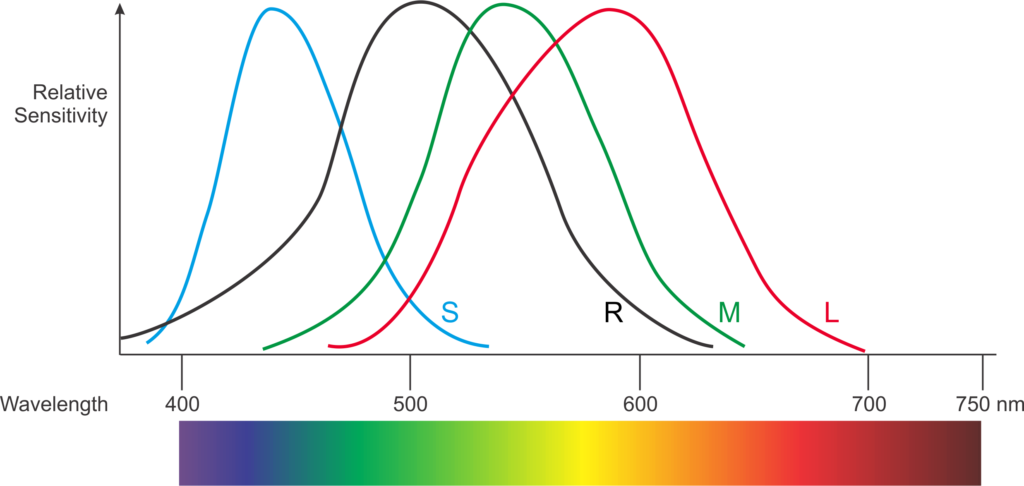
I snapped the image above many years ago during a visit to the Midlands Air Museum, near Coventry (England). It depicts the one-and-only Boulton-Paul P.111A research aircraft, which, due to its dangerous flight characteristics, was nicknamed the “Yellow Peril”.
I’ve posted this image now not to discuss the aerodynamics of the P.111A, but to consider its color. If you’re looking at the image on a computer monitor (including the screen of your phone, tablet or any similar digital device), you’re presumably seeing the plane’s color as bright yellow.
No Yellow Light Here
That, however, is an illusion, because no yellow light is entering your eyes from this image. What you are actually seeing is a mixture of red and green light, which, thanks to the limitations of the human visual system, fools your brain into thinking that you’re seeing yellow.
The Visible Spectrum
Most of us learn in school that what we see as visible light consists of a limited range of electromagnetic waves, having specific frequencies. Within the frequency range of visible light, most humans can distinguish a continuous spectrum of colors, as shown below.
(The wavelength range is in nanometers; nm)
We’re also taught that “white” light does not exist per se, but is instead a mixture of all the colors of light in the visible spectrum.
That’s a significant limitation of the human visual system; we can only see light whose frequency falls within a limited range. There are vast ranges of “colors” of light that aren’t visible to us. Presumably, our visual systems evolved to respond to the frequencies of light that were most useful to our ancestors in their own environment.
How do we see Color?
That leads to the question of how we can determine which light frequencies we’re seeing. Do our eyes contain some kind of detector cell that can measure the frequency of a ray of light? In fact, the system that evolution has bequeathed to us is a little more complex. Our eyes contain several different types of detector cell, each of which responds most strongly to light within a narrow frequency range.
There is one cell type called “rods” (because of their shape) that detect a relatively broad spectrum of light, but which are most sensitive to blue-green light. When the ambient light is low, the rods do most of the work for us, giving us monochrome vision.
There are also three types of cell called “cones”, the detection ranges of which overlap that of the rods. One type of cone is most sensitive to blue light, the second to green light, and the third to red. Given that blue light has the shortest visible wavelength, and red light the longest, the three types of cones are respectively called L (Long = Red), M (Medium = Green), and S (Short = Blue).
The diagram below shows the relative sensitivity of the rods (R) and cones (S, M, L) with respect to wavelength. I’ve also superimposed the color rainbow for convenience.
It’s thanks to the existence of the cone cells that we have color vision. The brain actually combines the information from all the detector cells, and determines from that which color we’re actually looking at.
Fooling the Brain
The nature of our visual system makes it possible to fool our brains into thinking that we’re seeing colors that are not actually present, by combining red, green and blue light in varying intensities.
Technology takes advantage of this limitation to provide what seem to be full-color images (or videos) that use only three color channels: one each for red, green and blue (hence the RGB acronym). Such color systems are known as “Additive Color”.
Conversely, printed color images are created using a three-color (or four-color, if black is added) system that is “Subtractive”. Subtractive systems use Cyan, Magenta, Yellow and optionally Black as their “primary” colors, leading to acronym CMYK. A continuous spectrum of color is achieved by overlaying translucent layers of CMYK in varying proportions. Subtractive color systems are a complex topic in themselves, so I don’t plan to go into further detail about them in this article.
Here’s a comparison of the features of additive versus subtractive color.
Additive Color
In an additive color system, you add colored lights together to create the illusion of a continuous spectrum.
The human brain creates the illusion of a continuous spectrum of colors.
It’s important to realize that, in an additive system, the colors do not somehow combine in space to create a color that’s not there. Instead, our brains combine the responses of the three types of cone in our eyes.
Subtractive Color
In a subtractive color system, you start with white light (or paper), then subtract particular colors from white.
In a printed image, overlaid color dyes block some light wavelengths, so the remaining wavelengths that pass through create the final color.
This is not an “optical illusion” in the same way as additive color. With subtractive color, the yellow light you see really is yellow.
Viewing a Color Image
Television and computer screens use additive color. The screen you’re viewing is comprised of a large matrix of red, green and blue dots. By varying the intensity of light from each of the dots across the screen, your brain is tricked into thinking that it’s seeing a continuous spectrum of color from blue to red. The size of each dot is so small that your brain merges the light from neighboring dots together.
Are You Looking at a Print, a Slide or a Screen?
So, if you’re reading this article on a computer screen, the image of the Boulton Paul P.111A that you can see isn’t actually shining any yellow light into your eyes, but is using red and green light to fool your brain into thinking that you’re seeing yellow.
Having said all that, my image of the P.111A was originally a Kodachrome 25 color slide. Kodachrome slides create colors using a subtractive process, overlaying translucent layers of secondary colors. Thus, if you could view the original slide, you would indeed see yellow light, created by subtracting blue light from a white source shining through the slide.
If this all seems very complex at first, don’t be deterred, because I know from personal experience that it’s easy to become confused even when you’ve been working with these principles for a long time. When designing digital video equipment years ago, I sometimes found myself forgetting that, in nature, yellow light really is yellow, and is not a mixture of red and green light!


